OPTOELECTRONICS BC0164AAA390 PDA Phone User Manual 2
OPTOELECTRONICS Co., Ltd. PDA Phone Users Manual 2
Contents
Users Manual 2

Chapter 3.
Phone Features
3.1 Making a Call
3.2 Configuring the Phone
3.3 In-Call Options
3.4 SIM Manager
3.5 Blocking Unwanted Phone Calls
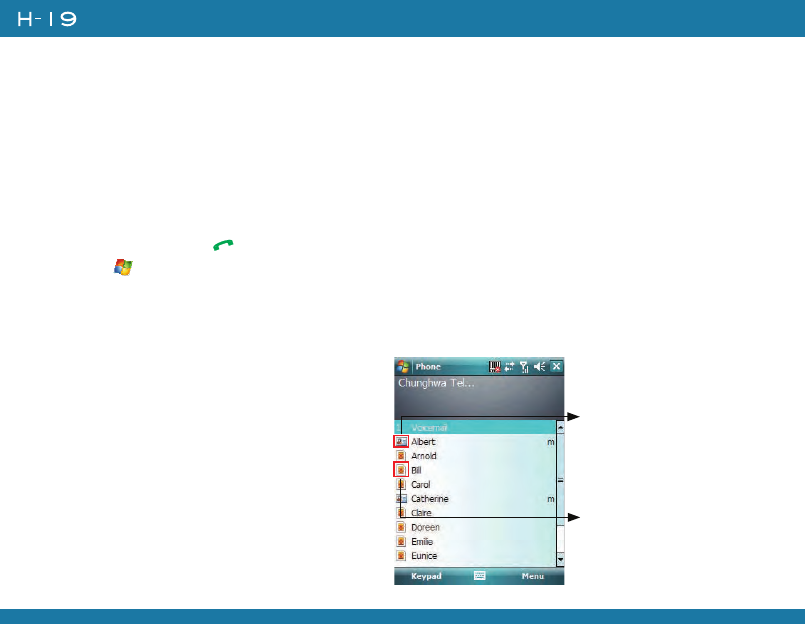
66
Chapter 3. Phone Features
You can use your device to make, receive, and keep track of calls, and send text messages (SMS,
Short Message Service) and MMS (Multimedia Messaging Service) messages. You can also dial a
phone number directly from Contacts, and easily copy SIM contacts to Contacts on the device.
3.1 Making a Call
The Phone Screen
From the Phone screen, you can open, call, or find a contact, and even save a new number in
Contacts. To access the Phone screen, do any of the following:
• Press the Talk key ( ).
• Tap > Phone.
Making a Call by Entering a Phone
Number
To enter phone numbers by tapping the
screen directly, you have to open the Phone
Keypad.
1. On the Phone screen, if the Phone
Keypad doesn’t show automatically, tap
Keypad. A Phone Keypad will show, you
can then enter the phone number.
SIM Contact
Outlook Contact
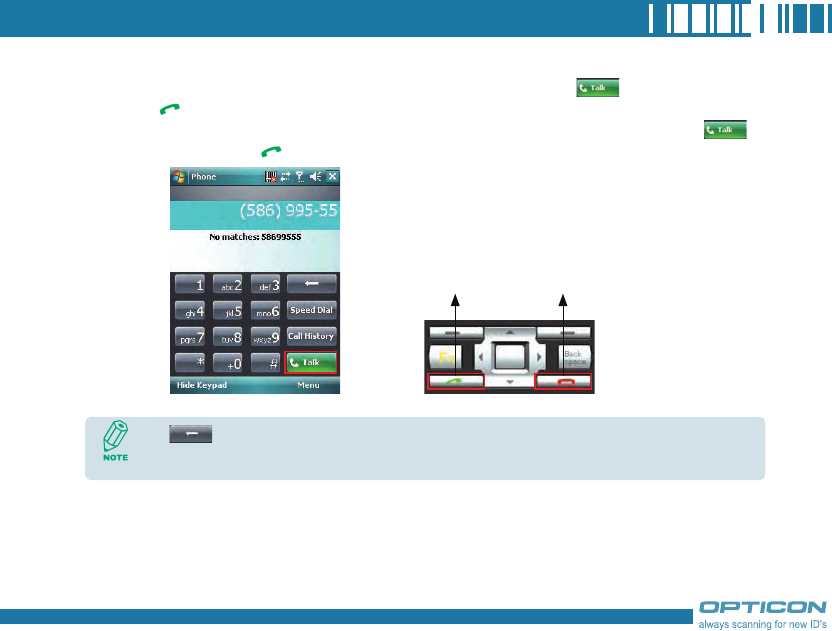
67
2. Do one of the following after entering the phone number:
• If you see the number or contact name to call, select it, then tap or press the TALK
( ) key.
• If you do not see the number or contact name, finish entering the number, then tap or
press the TALK ( ) key.
TALK Key END Key
Tap on the screen once to erase one single number; tap and hold it to erase a whole
string of numbers.
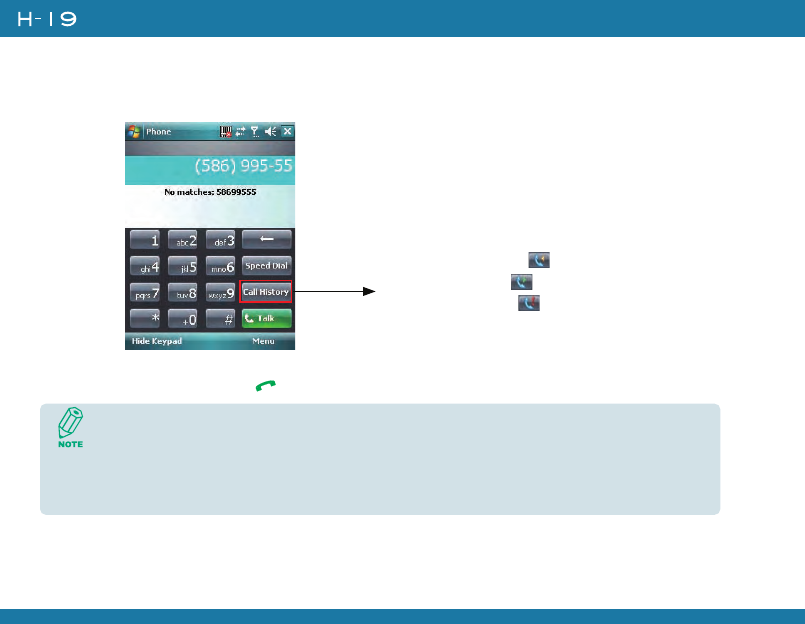
68
Chapter 3. Phone Features
Making a Call from Call History
Call History displays calls you have made, received, and missed.
1. On the Phone screen, tap the Call History button on the Phone keypad.
2. Select the name or phone number to call.
3. Tap Call or press TALK ( ).
Call History
1.Calls you received
2.Calls you made
3.Calls you missed
Tap a phone number or a contact in the Call History list displays history on all the calls
related to the contact or the phone number.
When someone who isn’t in your list of contacts calls you, you can create a contact during
the call from or from Call History by tapping Menu > Save to Contacts.
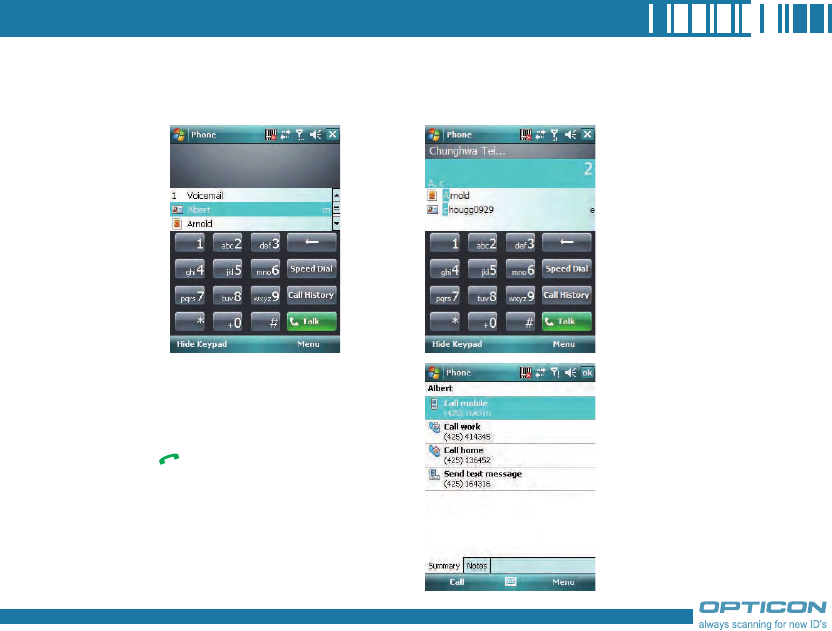
69
Making a Call from Contacts
1. On the Phone screen, tap on the desired contact in the list. You can quickly search through
Contacts by entering the first letter of the contact or the first number of his/her phone number.
2. Do one of the following:
• Tap on the number you want to dial;
otherwise, you can tap Call on the
screen or press TALK
( ).
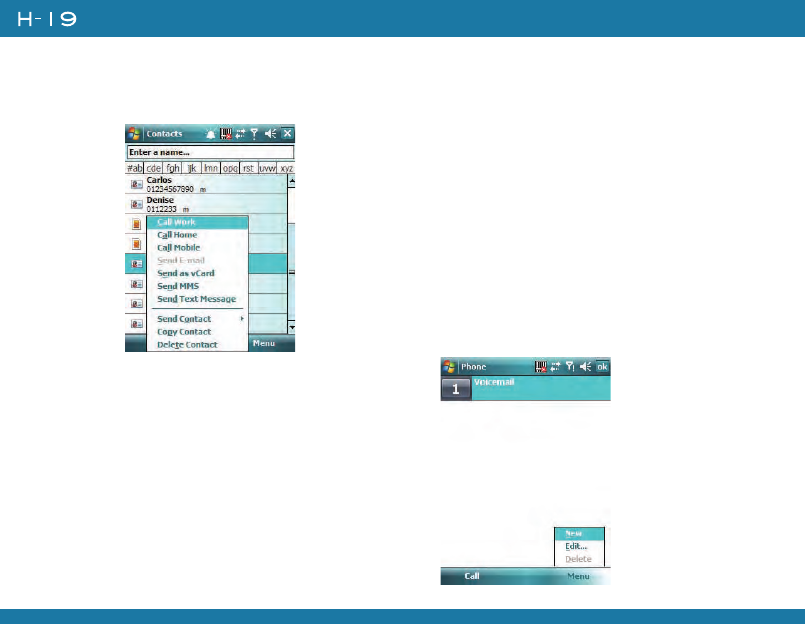
70
Chapter 3. Phone Features
• Tap and hold the contact and select
Call Work, Call Home, or Call
Mobile from the pop-up submenu.
Making a Call from Speed Dial
You can create speed dial entries for
frequently called numbers or frequently
accessed items so you can dial a number
by pressing a single key. For example, if you
assign location 2 to a contact in Speed Dial,
you can simply press and hold 2 on the
Phone keypad to dial the contact’s number.
Speed dials can be created only for numbers
that are stored in Contacts.
To create a speed dial entry for a contact
1. On the Phone screen, tap Speed Dial.
2. Tap Menu > New.
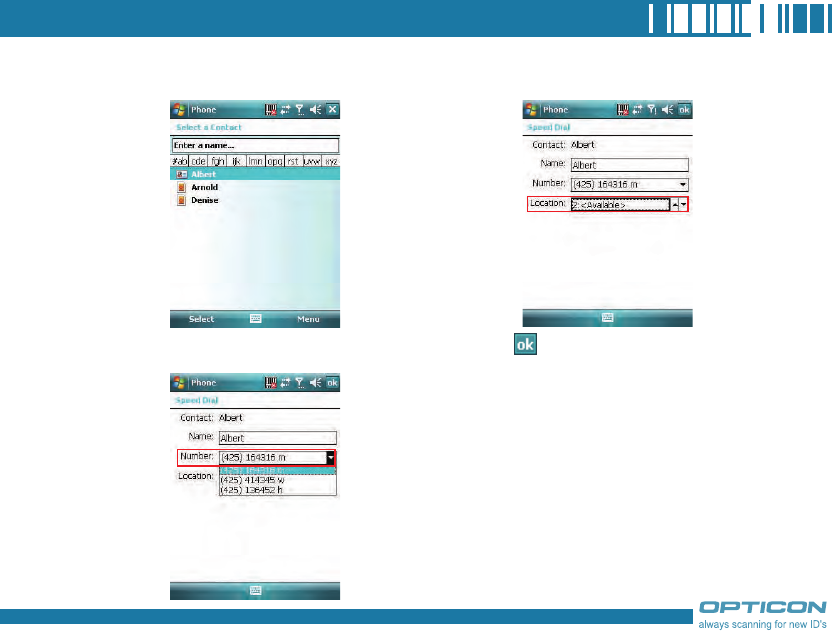
71
3. Tap the contact for whom to create a
speed dial.
4. Select the phone number for which to
create a speed dial.
5. In Location, select the speed dial number
to use.
6. Tap when finished.

72
Chapter 3. Phone Features
To retrieve a voicemail message
• On the Today screen, press and hold 1 to access your voice mailbox, and follow the prompts to
retrieve your message.
To delete a speed dial entry
• In the Speed Dial list, tap Menu > Delete.
Receiving/Rejecting a Call
When you receive a phone call, you have the option to answer it or ignore it.
To receive a call
• Tap Answer or press the TALK ( ) key to accept an incoming call.
To end a call
• Tap Ignore or press END ( ) to hang up a call.
The first speed dial location is generally reserved for your voicemail. Speed Dial uses
the next available location by default. If you want to place a number in a location that is
already used, the new number replaces the existing number.
Tap the Speed Dial button on the phone screen to check the success of creating a Speed
Dial entry.
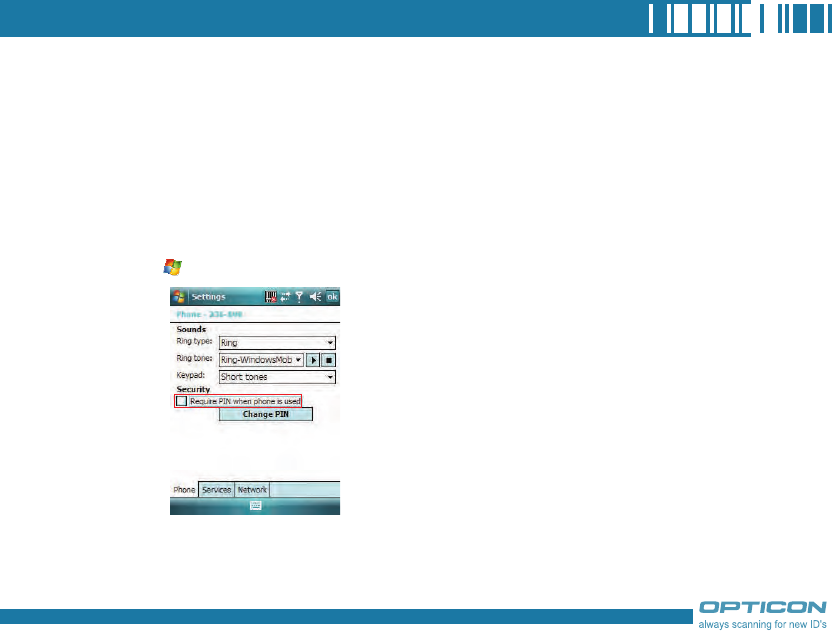
73
3.2 Configuring the Phone
Your wireless service provider may provide useful services such as Call Barring, Caller ID, Call
Forwarding, Call Waiting, Voice Mail and Text Messages and Fixed Dialing. You can get their settings
from the Network and change them.
Activating PIN Security
Most Subscriber Identity Module (SIM) cards are preset with a personal identification number (PIN)
that is provided by your wireless service provider. When PIN Security is activated, you need to
enter the PIN whenever you use your device.
1. Tap > Settings > Phone > Select Require PIN when phone is used.
2. Enter the preset PIN provided by your wireless service provider.
3. Tap Enter.
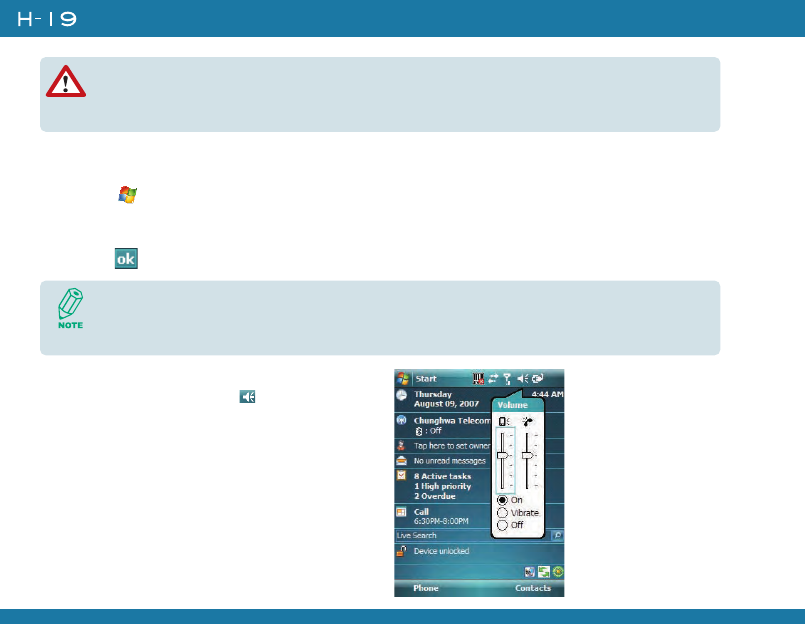
74
Chapter 3. Phone Features
Changing the Ring Type and Ring Tone
You can choose how to be notified for incoming calls.
1. Tap > Settings > Phone.
2. In the Ring type list, tap the desired option.
3. In the Ring tone list, select a ring tone.
4. Tap .
If your PIN is entered incorrectly three times, the SIM card will be blocked. If this happens,
you can unblock it with the PIN Unblocking Key (PUK) obtained from your wireless service
provider.
To use custom .wav, .mid, or .wma files as ring tones, use ActiveSync on your PC to copy
the file to the /Windows/Rings folder on your device. Then select the sound from the Ring
tone list.
Changing the Ringer Volume
1. Tap the volume button on the screen.
2. Move the slider to the desired volume
level.
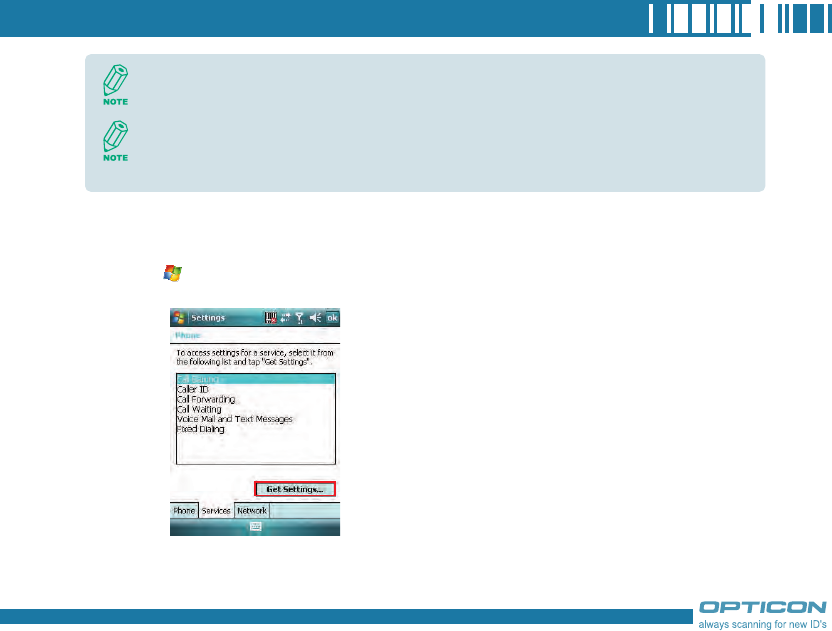
75
Blocking Incoming or Outgoing Calls
You will not be able to receive or make calls according to the options you choose.
1. Tap > Settings > Phone > Services tab.
2. Tap Call Barring > Get Settings.
Select On, Vibrate or Off to quickly change both the ringer and system volume and settings.
To adjust the earpiece volume during a call, press the VOLUME control on the device side
panel. Adjusting the volume at any other time can affect the ring and notification and MP3
sound levels.
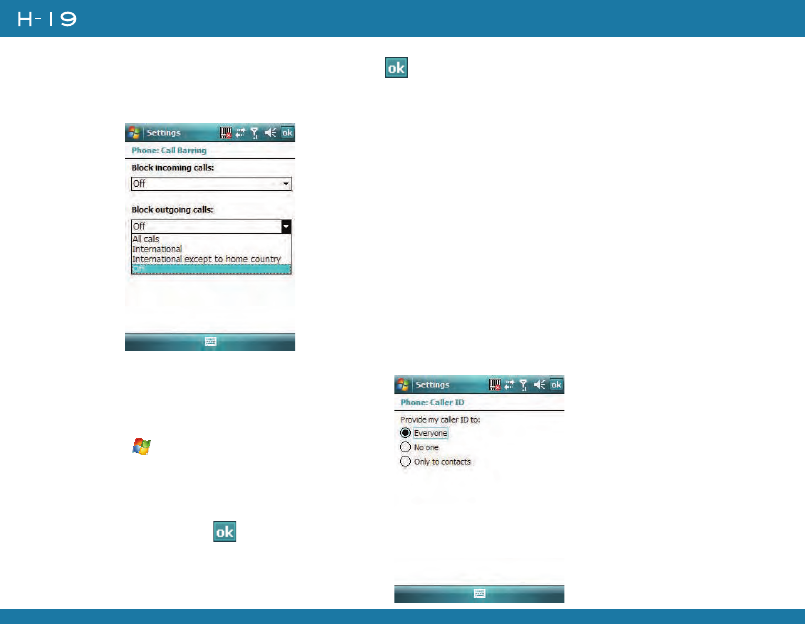
76
Chapter 3. Phone Features
3. Choose the calls you want to block, and tap .
• Block incoming calls: All calls, When roaming, Off.
• Block outgoing calls: All calls, International, International except to home country, Off.
Displaying Caller ID
You can provide a way for people to know
your identity when you are calling them.
1. Tap > Settings > Phone >
Services tab.
2. Tap Caller ID > Get Settings.
3. Select Everyone, No one or Only to
contact, and tap .
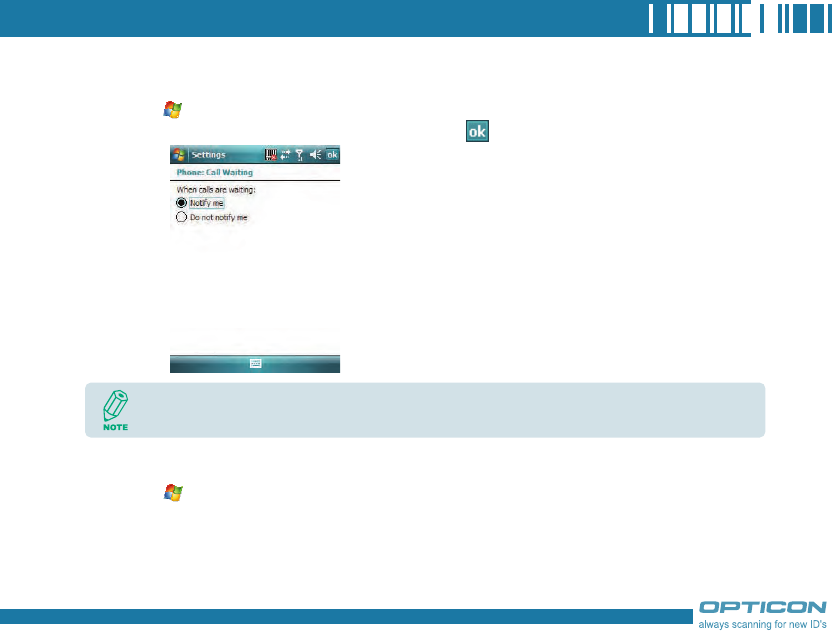
77
Call Waiting
When you are in another call, you will be notified of an incoming call if this option is selected.
1. Tap > Settings > Phone > Services tab > Call Waiting > Get Settings.
2. Select Notify me or Do not notify me, and tap .
Selecting a Network Manually
1. Tap > Settings > Phone > Network tab. Alternatively, you can tap Menu > Options
> Network tab from the Phone screen.
2. In the Network selection list, tap Manual. The list of available network is displayed.
To change phone settings alternatively, tap Menu > Options > Services tab from the
Phone keypad.
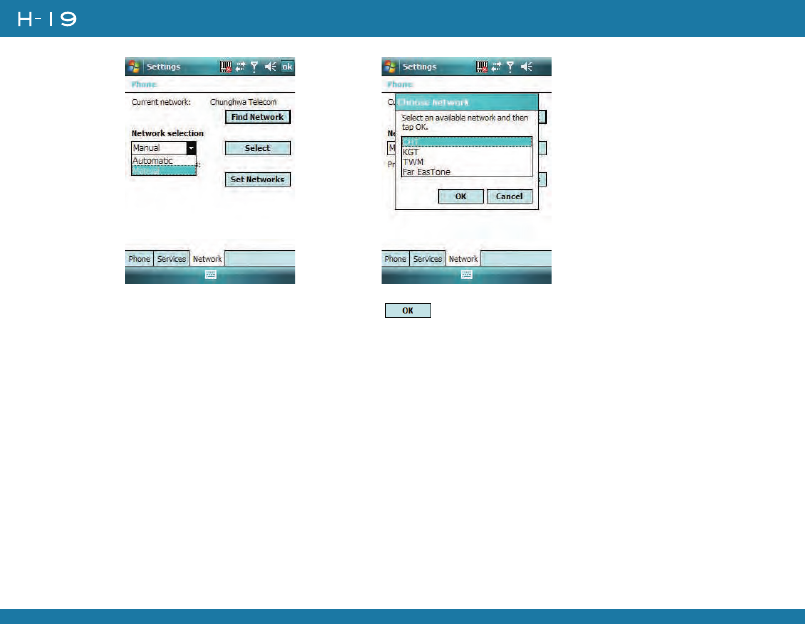
78
Chapter 3. Phone Features
3. Select the network you want to use, then tap .
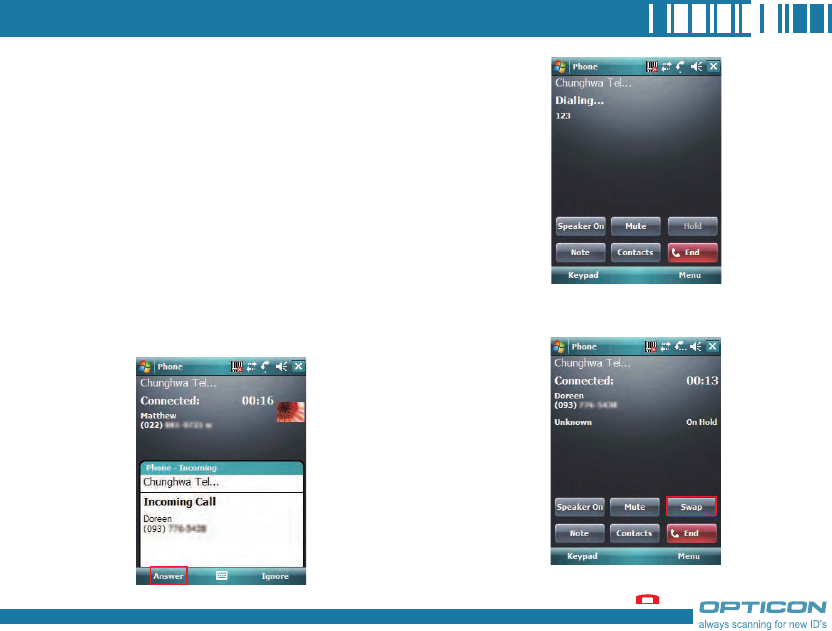
79
3.3 In-Call Options
Your device provides various options for managing multiple
calls at the same time. You are notified when you have another
incoming call, and you have the choice of ignoring or accepting
the call. If you are already on a call and accept the new call,
you can choose to switch between the two callers, or set up a
conference call between all three parties.
In-Call Options
Answering Another Call
1. Tap Answer to take the second call and
put the first call on hold.
2. To switch between two calls, tap Swap.
3. To end the second call and return to the
first call, press END ( ).
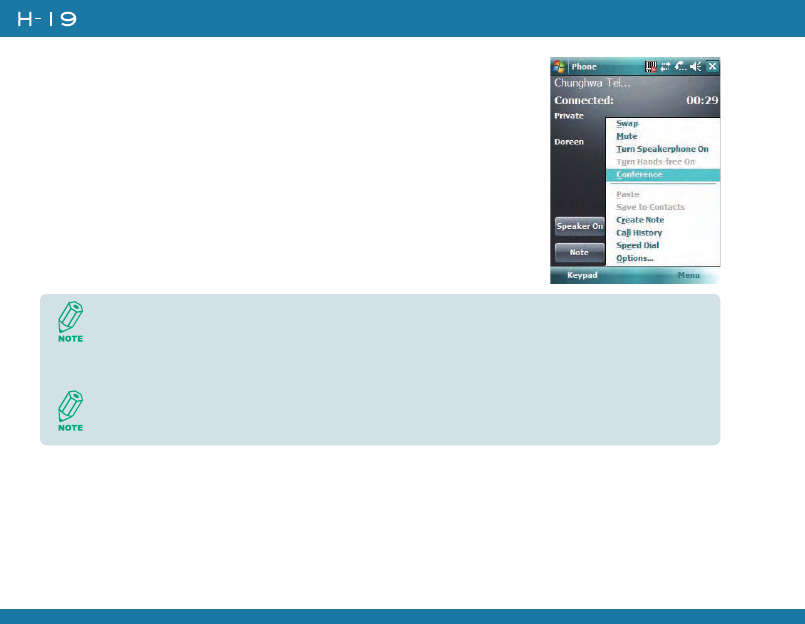
80
Chapter 3. Phone Features
Conference Call
1. Either put a call on hold and dial a second number; or accept a
second incoming call when you have one in progress.
2. Tap Menu and select Conference.
Turning On/Off the Speakerphone
Talk hands-free or let others hear your conversation with the built-in speakerphone in your device.
• Tap Speaker On during a call to turn the speaker on.
• Tap Speaker Off to turn the speaker off.
If the conference connection is successful, the word “Conference” will appear at the top of
the screen. To add additional persons to your conference call, tap Hold, enter the phone
number, and then tap Swap to return and continue.
Not all service providers support conference calling. Contact your service provider for
details.
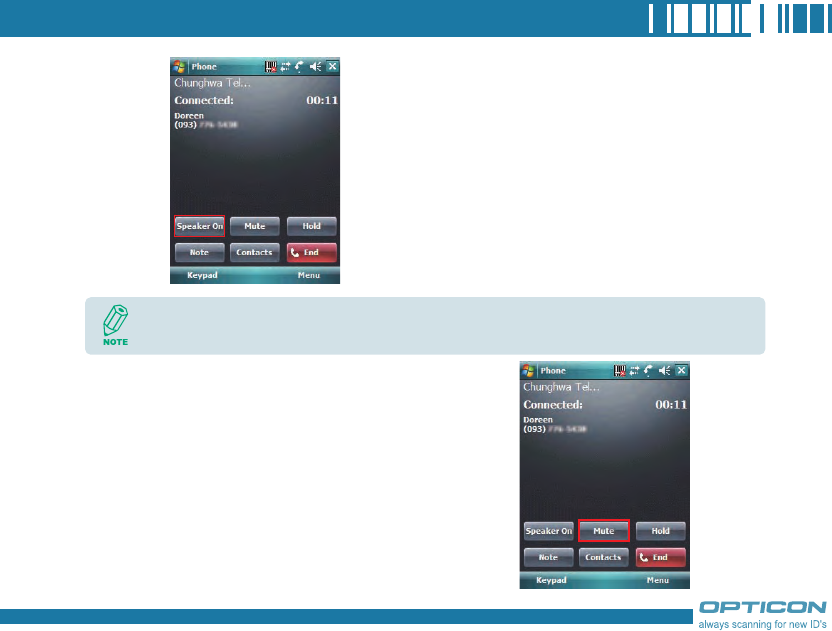
81
Muting the Microphone
The device’s microphone can be turned off during a
call. If you turn off the microphone the caller cannot
hear you. However, you can still hear the caller.
• Tap Mute during a call to turn the microphone off.
• Tap Unmute to turn the microphone on.
To avoid damage to your hearing, do not hold your device against your ear when the
Speakerphone is turned on.
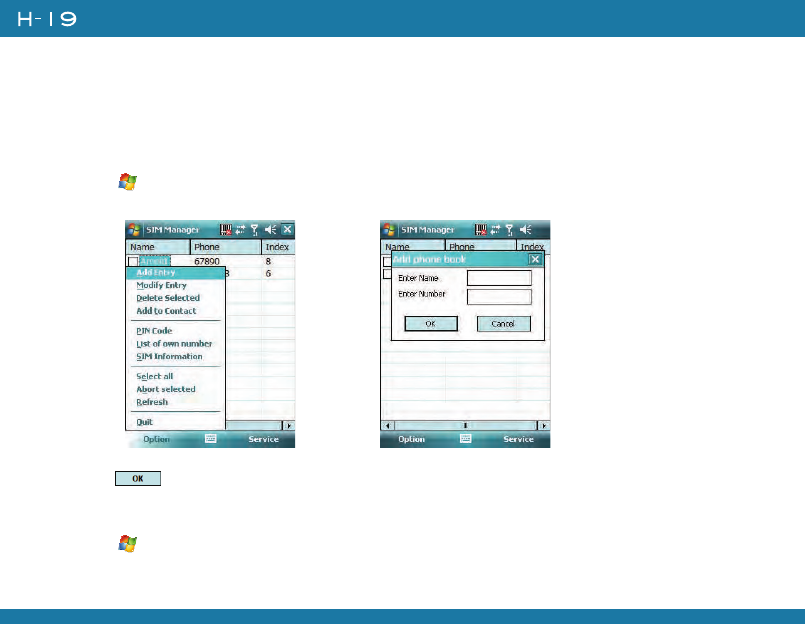
82
Chapter 3. Phone Features
3.4 SIM Manager
The SIM Manager helps you to manage the phonebook in your SIM card. Using the SIM Manager,
you can easily transfer phonebook entries from your SIM card to Contacts.
Adding a Phonebook Entry to the SIM Card
1. Tap > Programs > SIM Manager.
2. Tap Option > Add Entry and enter the name and phone number you want to add.
3. Tap .
Deleting Phonebook Entries from the SIM Card
1. Tap > Programs > SIM Manager.
2. Select the entries you want to delete by checking the checkboxes in front.
3. Tap Option > Delete Selected.
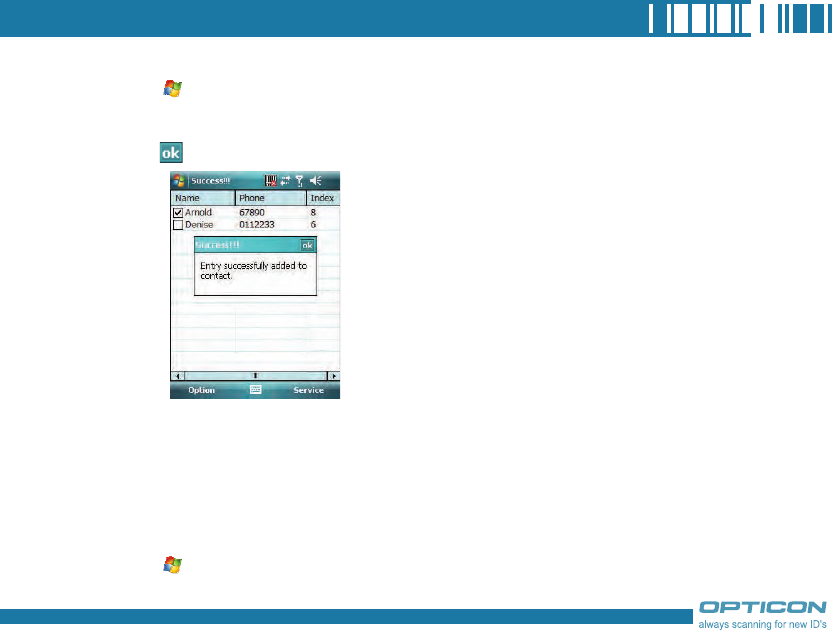
83
Saving Phonebook Entries to Contacts
1. Tap > Programs > SIM Manager.
2. Select the entries you want to save to Contacts by checking the checkboxes in front.
3. Tap Option > Add to Contacts.
4. Tap to close the notification dialog box.
3.5 Blocking Unwanted Phone Calls
You can set up a blacklist to block incoming calls from certain phone numbers. If a call is received
from a blacklisted number, your device will not ring or vibrate. Instead, this call will be blocked
automatically.
Rejecting Anonymous Calls
1. Tap > Programs > Blacklist.
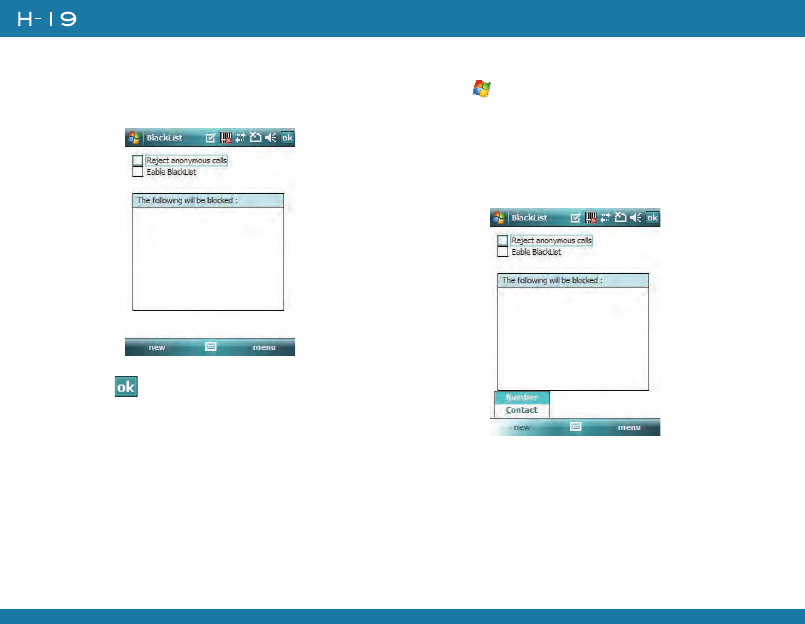
84
Chapter 3. Phone Features
2. Select or clear the checkbox in front of
Reject anonymous calls to enable or
disable this feature.
3. Tap .
Adding a Phone Number to the Blacklist
1. Tap > Programs > Blacklist.
2. Tap new and do one of the following:
• Tap Contact and select a contact to add
to the blacklist.
• Tap Number to add a phone number
directly.
3. Select the check box of Enable Blacklist
to block numbers listed in the Blacklist.
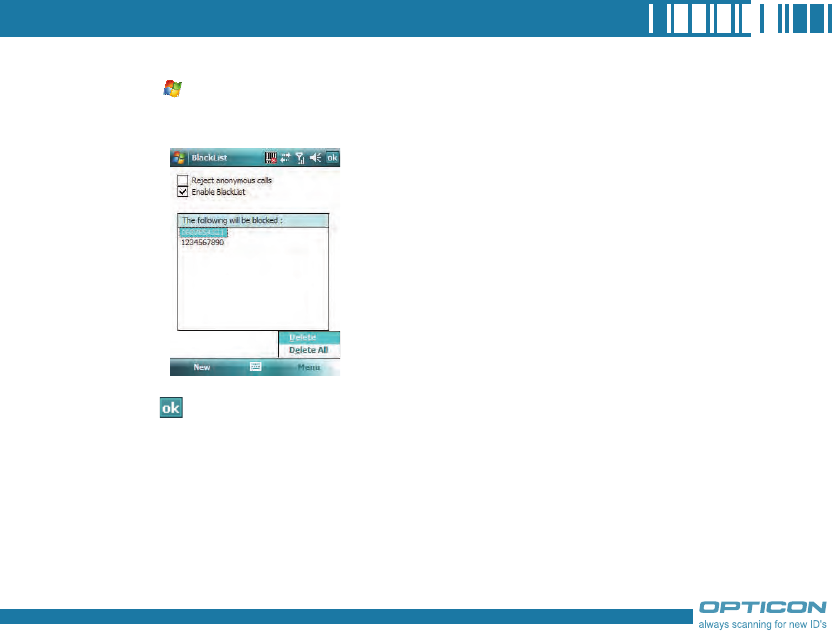
85
Removing a Phone Number from the Blacklist
1. Tap > Programs > Blacklist.
2. Select the number you want to remove from the blacklist.
3. Tap Menu > Delete.
4. Tap .

86
Chapter 3. Phone Features

Chapter 4.
Synchronizing Information
4.1 Installing and setting up ActiveSync
4.2 Synchronizing Information
4.3 Changing Settings for an Information
Type
4.4 Synchronizing with Exchange Server
4.5 Synchronizing via Bluetooth

88
Chapter 4. Synchronizing Information
ActiveSync synchronizes information on your device with information on your PC such as Outlook
content. ActiveSync can also synchronize over a wireless or cellular network with Exchange Server, if
your company or service provider is running Exchange Server with Exchange ActiveSync.
Specifically, you can use ActiveSync to:
• Synchronize information such as Outlook e-mail, contacts, calendar, or tasks information on your
device with your PC, as well as pictures, video, and music.
• Synchronize Outlook e-mail, contacts, calendar appointments, and tasks on your device directly with
Exchange Server so that you can stay up to date even when your PC is turned off.
• Copy files between your device and your PC without synchronizing.
• Select which types of information are synchronized and specify how much information is
synchronized. For example, you can choose how many weeks of past calendar appointments to
synchronize.
4.1 Installing and setting up ActiveSync
1. Install ActiveSync on your PC, as described on the Windows Mobile Getting Started Disc. After
Setup completes, the Synchronization Setup Wizard automatically starts when you connect your
device to the PC.
2. Follow the instructions on the screen to complete the wizard. In the Sync Setup Wizard, you
can:
• Create a synchronization relationship between your PC and the device.
• Configure an Exchange Server connection to synchronize directly with Exchange Server. To
synchronize your device with Exchange Server, obtain the name of the Exchange Server, your
user name, password, and domain name from your administrator before completing the
wizard.

89
• Choose information types to synchronize.
4.2 Synchronizing Information
To synchronize using ActiveSync, you must install ActiveSync on your PC before connecting your
device to the PC.
Starting and Stopping Synchronization Manually
1. Turn on the device.
2. Connect your device to your PC using a USB cable or Bluetooth. For more detailed information,
see "Connecting a mobile device to a PC" in ActiveSync Help on your PC.
3. Tap > Programs > ActiveSync.
4. To start synchronizing, tap Sync.
5. To stop synchronizing, tap Stop.
ActiveSync synchronizes a limited amount of information by default to save storage space on
your device. You can change the amount of information that is synchronized by performing the
following steps.
When you finish the wizard, ActiveSync synchronizes your device automatically. Once
synchronization completes, you can disconnect your device from your PC.
You can start and stop synchronization only if your device already has a sync relationship
with a PC or Exchange Server.
Some Anti-Virus software may conflict with ActiveSync.

90
Chapter 4. Synchronizing Information
Changing Which Information is Synchronized
1. Tap > Programs > ActiveSync.
2. Tap Menu > Options.
3. Do one or more of the following:
• Select the check box for the items you want to synchronize. If you cannot select a check box,
you might have to clear the check box for the same information type elsewhere in the list.
• Clear the check box for any items you want to exclude.
• To customize synchronization of a computer, select the computer name then click Settings.
• To customize synchronization of particular information, select the information type then click
Settings.
• To stop synchronizing with one computer completely, select the computer name and click
Delete.
You can change this setting only if your device already has a sync relationship with a PC.
Please disconnect your device from your PC before changing this setting.
Outlook e-mail can be synchronized with only one computer.
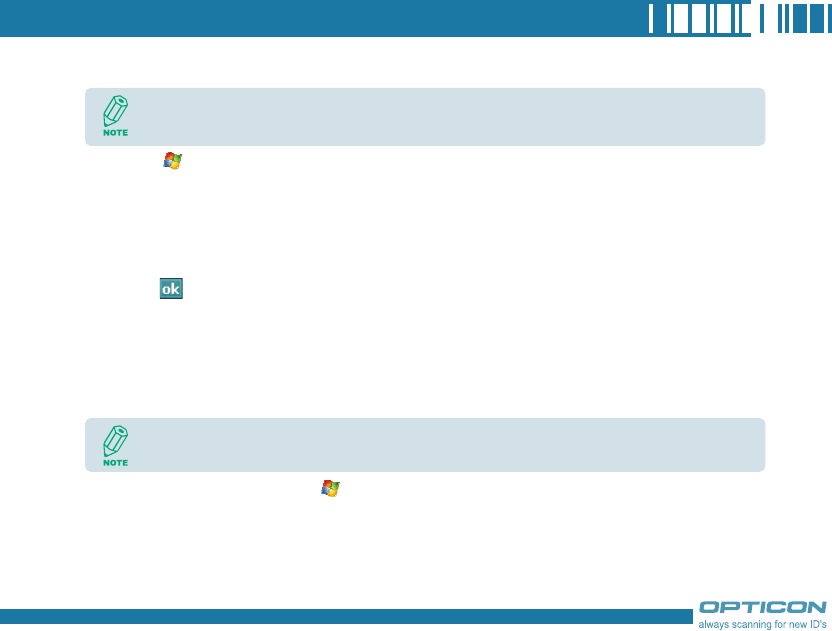
91
4.3 Changing Settings for an Information Type
1. Tap > Programs > ActiveSync > Menu > Options.
2. Select one of the information types.
3. Do one of the following:
• To view or change settings for an information type (when available), tap Settings.
• To view or change settings for a computer or Exchange Server, tap Settings.
4. Change the amount of information to be synchronized or other settings.
5. Tap (or Finish in the Exchange Server settings wizard).
4.4 Synchronizing with Exchange Server
To set up your device to synchronize directly with Exchange Server, you will need to get the name of
the server and the server domain name from your service provider or system administrator. You must
also know your Exchange user name and password.
1. On your device screen, tap > Programs > ActiveSync > Menu > Configure Server.
If you have not yet set up sync with Exchange Server, this will say Add Server Source.
2. In Server address, enter the name of the server running Exchange Server, and tap Next.
3. Enter your user name, password, and domain name, and tap Next.
4. If you want the device to save your password so that you will not need to enter it again when
Before changing settings for an information type on the device, disconnect it from your PC.
Before changing synchronization settings on the device, disconnect it from your PC.

92
Chapter 4. Synchronizing Information
connecting, select the Save password check box.
5. Select the check boxes for the types of information items that you want to synchronize with
Exchange Server.
6. To change available synchronization settings, select the type of information, and tap Settings.
7. To change the rules for resolving synchronization conflicts, tap Advanced.
8. Tap Finish.
4.5 Synchronizing via Bluetooth
Connecting to a PC Using Bluetooth
1. Follow the instructions in ActiveSync Help on the PC for configuring Bluetooth on your PC to
support ActiveSync.
2. Tap > Programs > ActiveSync.
3. Tap Menu > Connect via Bluetooth. Ensure that the device and PC are within close range.
4. If this is the first time you have connected to this PC via Bluetooth, you must complete the
Bluetooth wizard on the device and set up a Bluetooth partnership with the PC before
synchronizing.
5. Tap Sync.
6. When finished, tap Menu > Disconnect Bluetooth.
You can also use the Sync Setup Wizard to set up the device to synchronize remotely with
the Exchange Server. This wizard is started when you connect your device to your PC after
installing ActiveSync on the PC.
To preserve battery power, turn off Bluetooth.

Chapter 5.
Bluetooth Connections
5.1 Bluetooth Modes
5.2 Bluetooth Partnership (Bonding)
5.3 Beaming Information (Bluetooth)

94
Chapter 5. Bluetooth Connections
Bluetooth is a short-range wireless communications technology. Devices with Bluetooth capabilities
can exchange information over a distance of about 10 metres without requiring a physical connection.
You can even beam information to a device in a different room, as long as it is within range.
The software included with your device allows you to use Bluetooth in the following ways:
• Beam information, such as files, appointments, tasks, and contact cards, between devices that have
Bluetooth capabilities.
• Create a connection between your device and a Bluetooth phone to use the phone as a modem.
5.1 Bluetooth Modes
Bluetooth on your device operates in three different modes:
1. On. Bluetooth is turned on and you can use Bluetooth features.
2. Off. Bluetooth is turned off. In this mode, you can neither send nor receive information using
Bluetooth. You might want to turn off the radio at times to conserve battery power, or in
situations where radio use is prohibited, such as onboard an aircraft and in hospitals.
3. Visible. Bluetooth is turned on, and all other Bluetooth-enabled devices within a range of 10
meters can detect your device.
By default, Bluetooth is turned off. If you turn it on, and then turn off your device, Bluetooth
also turns off. When you turn on your device again, Bluetooth automatically turns on.
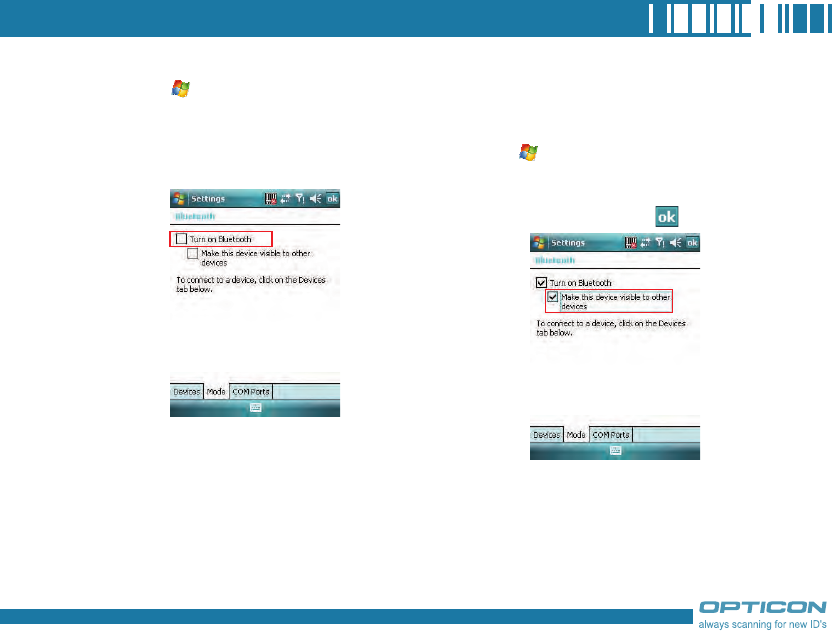
95
Turning Bluetooth On or Off
1. Tap > Settings > Connections
tab> Bluetooth.
2. Tap Mode tab, check or uncheck the
checkbox in front of Turn on Bluetooth
to turn on or off Bluetooth.
Making Your Device Visible
To receive beamed information, beaming
devices or computers must be able to detect
your device.
1. Tap > Settings > Connections tab
> Bluetooth.
2. Select Make this device visible to
other devices, and tap .
Other Bluetooth-enabled devices can now
detect your device and attempt to beam
information to it, establish a Bluetooth
partnership, or use a Bluetooth service.
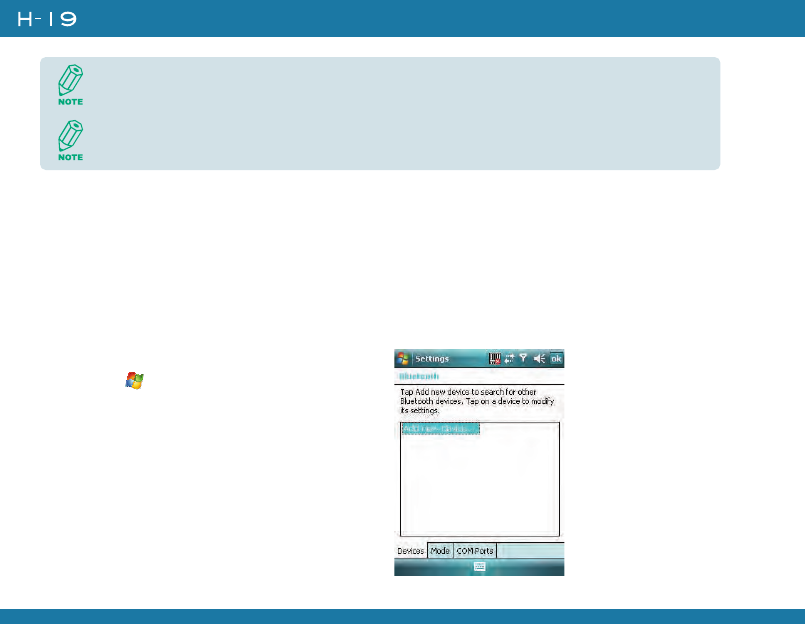
96
Chapter 5. Bluetooth Connections
5.2 Bluetooth Partnership (Bonding)
A Bluetooth partnership is a relationship that you create between your device and another Bluetooth-
enabled device in order to exchange information in a secure manner. Creating a partnership between
two devices involves entering the same personal identification number (PIN) on both devices, and this
is a one-time process. Once a partnership is created, the devices can recognize the partnership and
exchange information without entering a PIN again. Make sure the two devices are within a range of
10 meters, and Bluetooth is turned on and in discoverable mode.
Selecting Make this device Visible to other devices also turns on Bluetooth.
Turning off Bluetooth will make your device not visible, and it will also prevent you from
sending a Bluetooth beam.
Creating a Bluetooth Partnership
1. Tap > Settings > Connections
tab> Bluetooth > Devices tab.
2. Tap Add new device. Your device
searches for other Bluetooth-enabled
devices and displays them in the list.
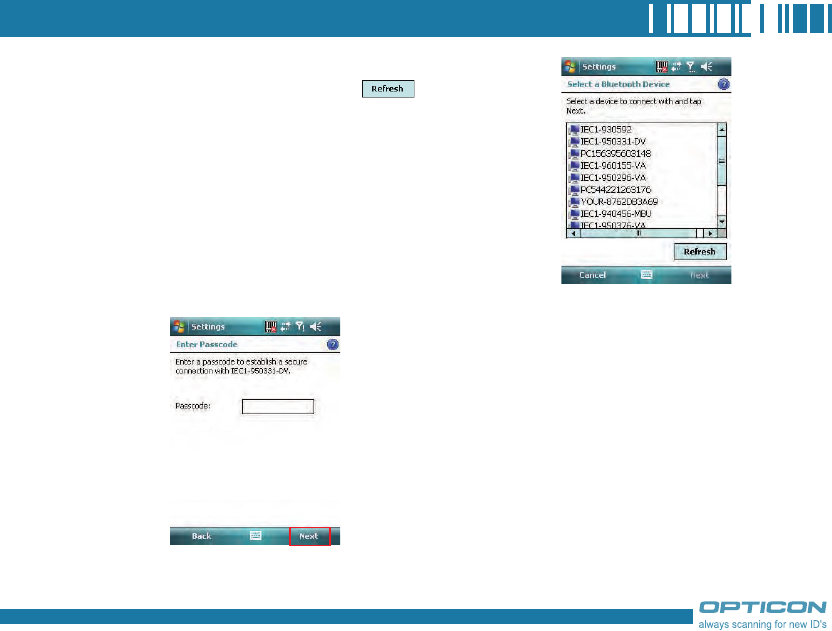
97
3. Select the device with which you want to create a Bluetooth
partnership, and tap Next. Tap if the device you
want to connect is not listed.
4. In Passcode, if you want to use a passcode (recommended
for enhanced security), enter an alphanumeric passcode
between 1 and 16 characters, and tap Next. Otherwise,
leave the passcode blank.
5. Enter the same passcode on the other device.
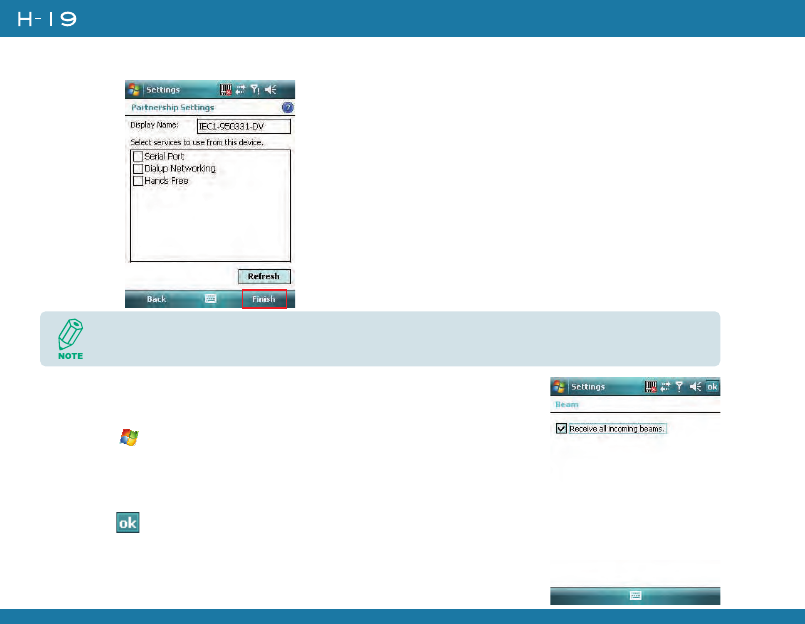
98
Chapter 5. Bluetooth Connections
6. Select the service to use from the device, and tap Finish.
5.3 Beaming Information (Bluetooth)
Receiving Beamed Information
1. Tap > Settings > Connections tab > Beam.
2. Select Receive all incoming beams.
3. To receive beams by using Bluetooth, ensure Bluetooth is turned on
and that your device is discoverable and within close range.
4. Tap .
Once you create a partnership, the Bluetooth-enabled devices don't need to be visible to
beam information between them; Bluetooth needs only to be turned on.

99
Beaming an Item
In the Calendar, Contacts, Notes, Tasks, and Pictures programs, you can beam files and
information to other devices using Bluetooth.
1. From the program, select the item you want to beam, such as an appointment in Calendar,
a task in Tasks, a contact card in Contacts, a picture in Pictures, a file in File Explorer. In
Calendar, for example, first open the appointment in Agenda view.
2. Tap Menu > Beam.
3. Your device will search and show visible devices, select the device to which you want to send
the item.
Once you select Receive incoming beams, your device automatically receives beams until
you clear this check box.
Your device can receive all types of beamed files, but you may not be able to view all types
of files on the device. You may need to copy some files to a PC for viewing.
When using Bluetooth, if the device that you want to beam to doesn't appear in the list,
ensure that the device is turned on, visible, and within close range of your device. Also,
ensure that Bluetooth is turned on.
You can obtain the Bluetooth BD Address of your device. Tap > Settings > System
tab > Device Info > Hardware tab.

100
Chapter 5. Bluetooth Connections

Chapter 6.
Transferring Files To and
From Your Device
6.1 Using ActiveSync
6.2 Transferring from Memory Cards
6.3 Using Bluetooth
6.4Transferring to a PC or Other
Devices
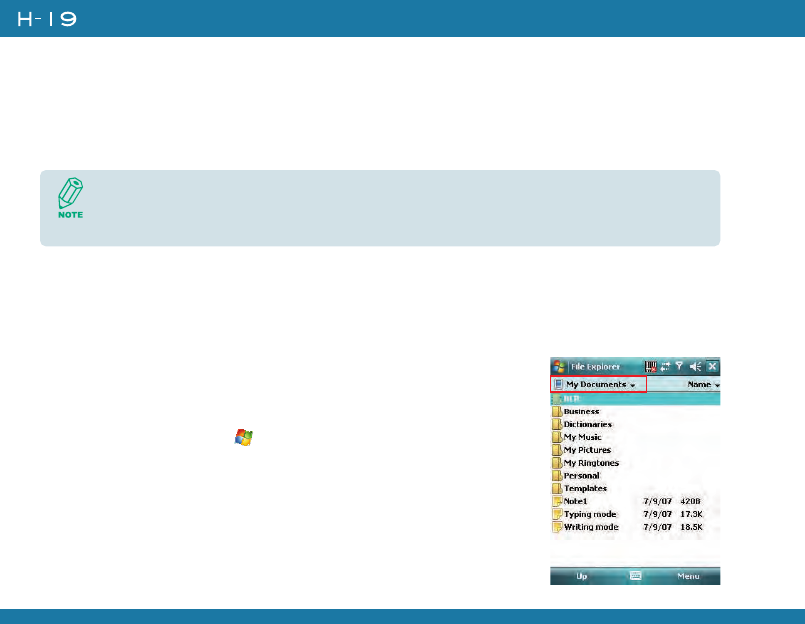
102
Chapter 6. Transferring Files To and From Your Device
You may need to transfer application data such as Word documents, Excel spreadsheets, PowerPoint
slides, and/or media files from your PC to your device. This section describes different methods to
transfer files from a PC to your device.
6.1 Using ActiveSync
1. Connect your device to the PC with the USB cable. Microsoft ActiveSync should be
automatically launched on the PC if it is set up correctly.
2. Select an information type under Synchronization Options in the Synchronization Setup Wizard
by checking the checkbox in front of it.
3. Click the Settings button and add the files you want to transfer.
Click the OK button when you finish.
4. Click Next, and then click Finish to start the synchronization
process.
5. On your device, tap > Programs > File Explorer. The files
should be saved to My Documents. Check to see if the files have
been transferred to your device successfully.
To transfer files from PC to your device with ActiveSync, you must install Microsoft
ActiveSync on the PC first. Please refer to Chapter 4 Synchronizing Information for detail on
how to install and set up ActiveSync.
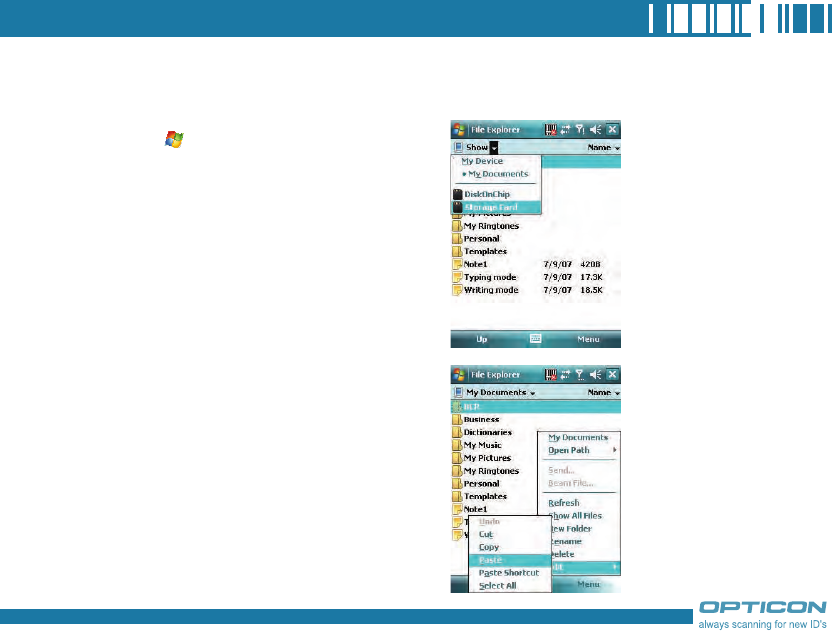
103
6.2 Transferring from Memory Cards
1. Insert your memory card into the device’s mini-SD card slot. (See “1.5 Mini-SD cards” for
details.)
2. Tap > Programs > File Explorer.
3. In the Show list, select Storage Card.
4. File Explorer should display all the files stored
in your memory card. Tap and hold the file
you want to transfer, and select Copy.
5. From the Show list in File Explorer, go to
destination folder. (For example, My Device
> My Documents.)
6. Tap Menu > Edit > Paste.

104
Chapter 6. Transferring Files To and From Your Device
6.3 Using Bluetooth
1. On your PC, locate the file you want to send using Bluetooth with Windows Explorer.
2. Right-click the file and select the device you want to transfer the file to under “Send To >
Bluetooth.”
3. Tap Yes when your device prompts about receiving a file.
4. After the transmission process is finished, the file should be saved in your device under My
Documents in the File Explorer.
6.4 Transferring to a PC or Other Devices
Please refer to Section 5.3 “Beaming Information (Bluetooth)” for details.
Before receiving files, you must turn Bluetooth on and establish a Bluetooth partnership
between your PC and your device. (See “Chapter 5. Bluetooth Connections” for details.)

Chapter 7.
C o n n e c t i n g t o t h e
Internet
7.1 Setting up Internet connections
7.2 Using Internet Explorer Mobile
7.3 Using Wireless Manager
7.4 Using a Wi-Fi Connection

106
Chapter 7. Connecting to the Internet
7.1 Setting up Internet connections
Your device’s powerful networking capabilities allow you to access the Internet or your corporate
network at work through wireless and conventional connections. Specifically, you can configure
your device to establish a connection via GPRS or Proxy.
With an active connection on your device, you can browse the Web, download e-mails, or use
MSN Messenger. Check with your service provider to see if a connection has already been set up
for you, and if over-the-air configuration is supported.
If you need to manually set up a connection, it is important that you obtain the following
information from your Internet Service Provider (ISP) or the company whose intranet you are trying
to access:
• User name
• Password
• Access point name (required for GPRS connection)
• Domain name (required for accessing a corporate network or an intranet)
Creating a GPRS Connection
Every network connection is different. You should gather all of the relevant information or network
settings you need before starting this process.
1. Tap > Settings > Connections tab > Connections.
2. Tap Add a new modem connection.
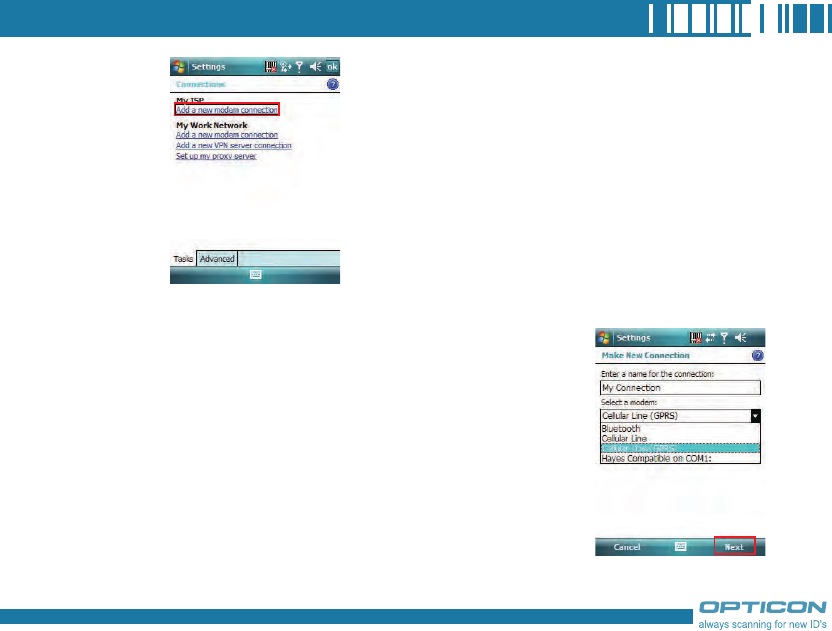
107
3. Enter the following information (you may or may not need to enter all of the following
information), and tap Finish.
• Enter a name for the connection.
• In Select a modem, select Cellular Line (GPRS). Then tap
Next.
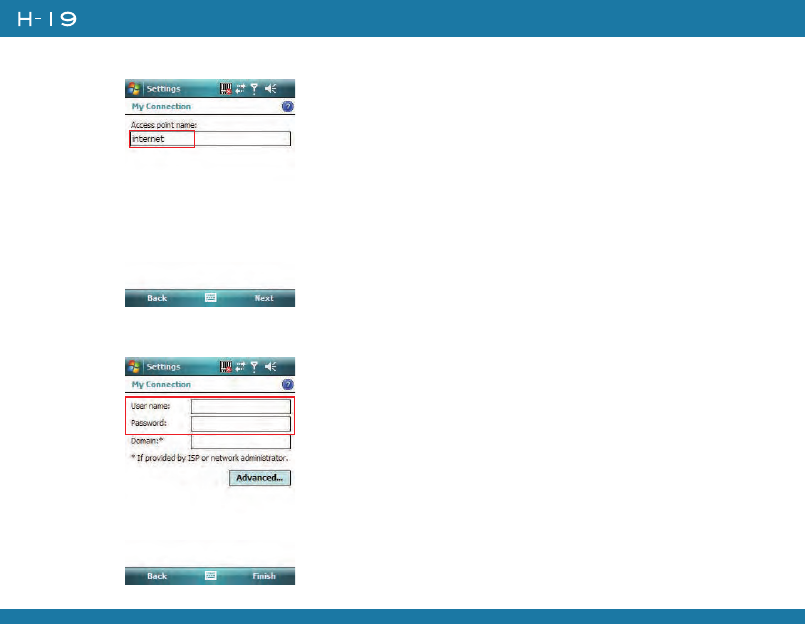
108
Chapter 7. Connecting to the Internet
• In Access point name, enter the access point name, then tap Next.
• In User name, enter your user name for the GPRS network, if required.
• In Password, enter your password, if required.

109
• Tap Advanced > Servers tab. In DNS, enter the primary Domain Name System (DNS)
address, if required.
• In Alt DNS, enter the secondary DNS address, if required.
• Tap TCP/IP tab. In Use specific IP address, enter the Internet Protocol (IP) address for the
device, if required.
The device uses this connection when you open a program that connects to the Internet.
Creating a Proxy Connection
Every network connection is different. You should gather all of the relevant information or network
settings you need before starting this process.
1. Tap > Settings > Connections tab > Connections.
2. Tap Set up my proxy server.
3. Check the checkbox in front of This network connects to the Internet.
4. Check the checkbox in front of This network uses a proxy server to connect to the
Internet.
5. Under Proxy server, enter the proxy server name.
6. If the proxy server uses a different port or requires a username
and password tap Advanced, select the proxy type to change its
settings, then enter username, password and/or port number in the
proper fields.
7. Tap .
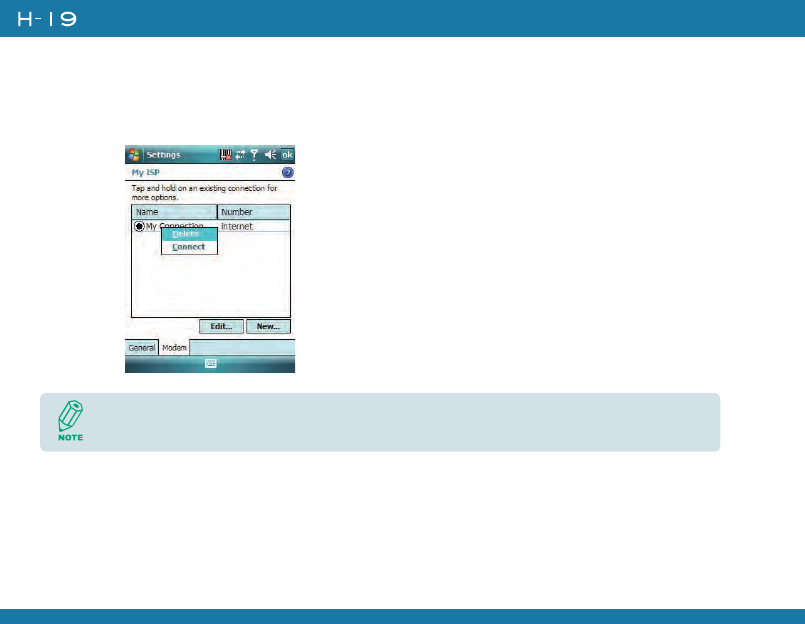
110
Chapter 7. Connecting to the Internet
Deleting a Connection
1. Tap > Settings > Connections tab > connections.
2. Tap Manage existing connections.
3. Tap and hold on the connection you want to delete and select Delete.
The device cannot connect to a PC through ActiveSync while connecting to the Internet
using GPRS.
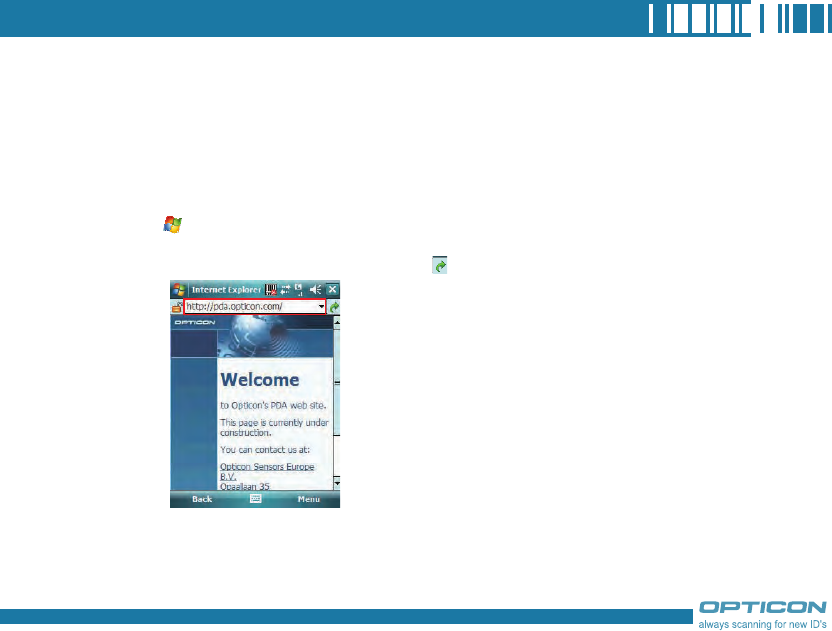
111
7.2 Using Internet Explorer Mobile
Internet Explorer Mobile is a full-featured Web browser, optimized for use on your device. You can use
Internet Explorer Mobile to browse the Internet once you have set up your Internet connection (if you
haven’t done so, please read the previous chapter before continuing).
Browsing the Internet
1. To browse the Internet you must have a valid connection established.
2. Tap > Internet Explorer.
3. Do any of the following:
• Enter the address in the address bar, then tap .
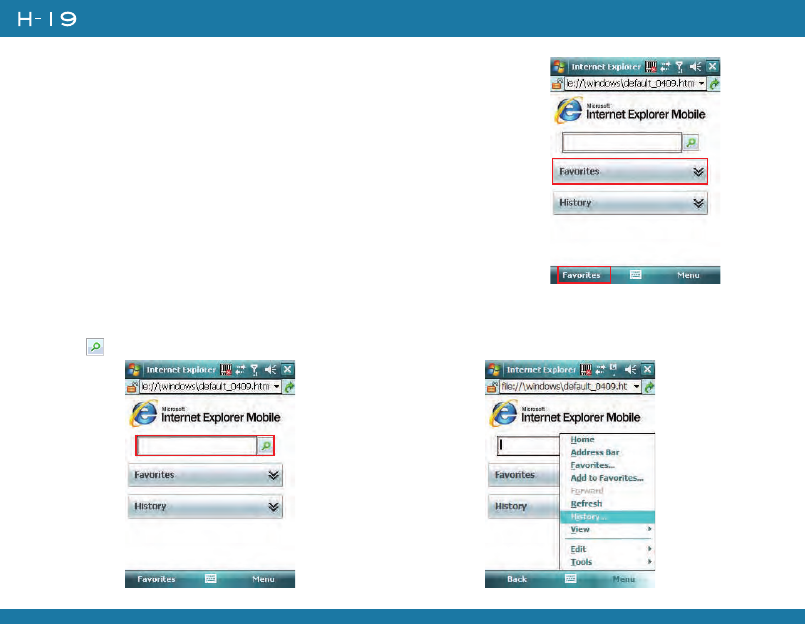
112
Chapter 7. Connecting to the Internet
• Tap Favorites then select a Web Page. You can scroll down the
Favorites box and select one alternatively.
• Highlight the search box and type in a
term that you want to search for. Then tap
to begin search .
• Select Menu > History, then select a
Web Page. You can scroll down to the
History box and select one alternatively.

113
Adding a Web Page to the Favorite List
1. Tap > Internet Explorer.
2. Go to the page you want to add, tap Menu > Add to Favorites.
3. Confirm or change the name and Web page address.
4. In Create in, select a folder for this favorite.
5. Tap Add.
Deleting a Favorite
1. Tap > Internet Explorer.
2. Tap Favorites.
3. Tap Add / Delete tab.
4. Select the favorite to delete.
5. Tap the Delete button.
6. Tap Yes to confirm the deletion.
To change the Home page, go to a Web page, tap Menu > Tools > Options >
General tab, and choose to use the displayed page as your Home page.
A quick way to add favorites to your device is to synchronize with your PC using ActiveSync.
For more information, see ActiveSync Help on your PC.

114
Chapter 7. Connecting to the Internet
Changing the Size of Text on Web Pages
1. Tap > Internet Explorer.
2. Tap Menu > View > Text size and select the size you want.
There are five zoom options you can select: Largest / Larger / Medium / Smaller / Smallest.
Showing or Hiding Pictures on Web Pages
1. Tap > Internet Explorer.
2. Tap Menu > View > Show Pictures.
A check mark next to Show Pictures indicates that pictures will be displayed.
Changing Web Page Display Options
1. Tap > Internet Explorer.
2. Tap Menu > View.
3. Select one of the following:
• One Column. Arranges the content into one column that is as wide as the screen. This
means that you will rarely have to scroll horizontally.
• Fit To Screen. Maintains a layout similar to what you see on a desktop computer, but makes
items smaller and arranges the content so that you can see most of it without having to scroll
horizontally.
• Desktop. Keeps the same layout and size as on a desktop computer, which will require both
horizontal and vertical scrolling.
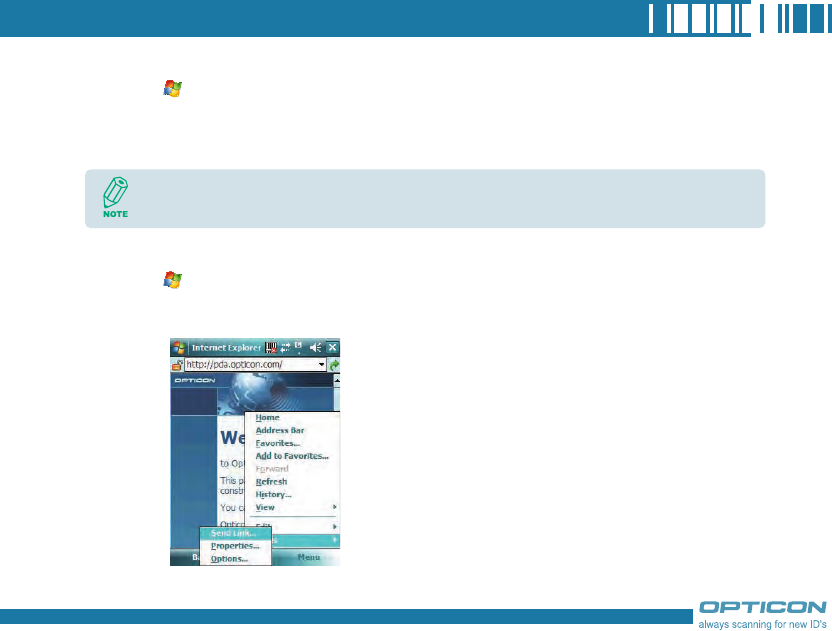
115
Viewing a Page in Full Screen Mode
1. Tap > Internet Explorer.
2. Do either of the following:
• Tap Menu > View > Full Screen.
• Tap and hold on the screen with stylus, and then tap Full Screen on the pop-up menu.
Sending a Link via E-mail
1. Tap > Internet Explorer.
2. Go to the page you want to send.
3. Tap Menu > Tools > Send Link.
To exit full screen mode, press either SOFT KEY, and then tap Menu > View > Full
Screen to cancel the selection.
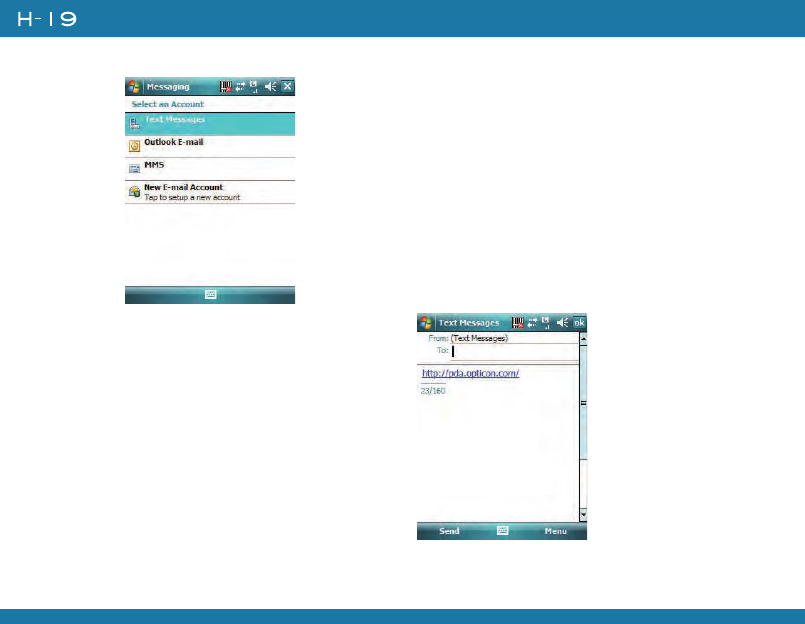
116
Chapter 7. Connecting to the Internet
4. Select an account.
5. A new message is created with the page
address inserted in the message body. You can
then enter the recipient’s phone number and
edit the message.
6. Tap Send to send the message.
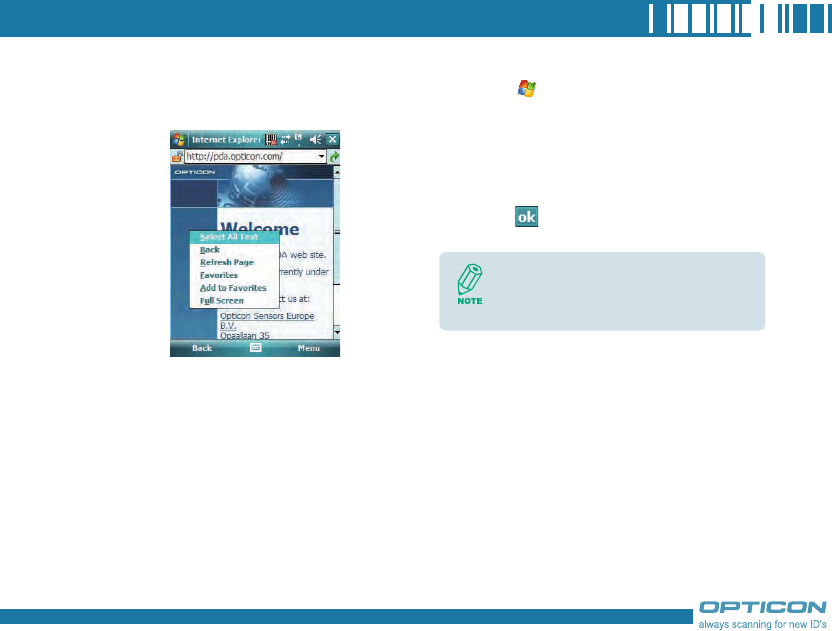
117
Copying Text from a Web Page
1. In Internet Explorer Mobile, tap and hold
the page, and tap Select All Text.
2. Tap and hold the page, and tap Copy.
3. Open an application (e.g. open a new
Note), tap and hold on the screen, and
tap Paste to save the text.
Clearing History or Temporary Files
1. Tap > Internet Explorer.
2. Tap Menu > Tools > Options.
3. Tap Memory tab.
4. Change the number in the day(s) box if
needed.
5. Tap Clear History or Delete Files, then
tap .
To clear cookies, tap Menu > Tools
> Options > Security tab, then tap
Clear Cookies.
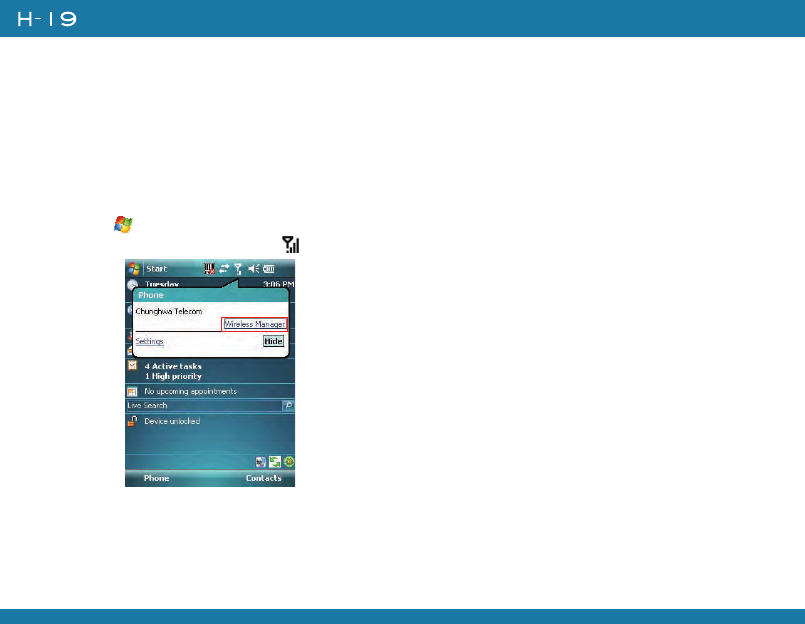
118
Chapter 7. Connecting to the Internet
7.3 Using Wireless Manager
Wireless Manager is a program that allows you to conveniently turn on or off the various wireless
connections on the Windows Mobile-based device, including cellular phone, Bluetooth and Wi-Fi.
Opening Wireless Manager
To open the Wireless Manager, do one of the following:
• ap icon on the screen to open the Wireless Manager directly.
• Tap > Settings > Connections tab > Wireless Manager.
• Tap the signal strength icon ( ) at the top of the screen, and tap Wireless Manager.
Enabling and Disabling a Feature
There are three buttons in the Wireless Manager; each of them represents one certain feature. You
can simply tap a button to activate its corresponding feature.
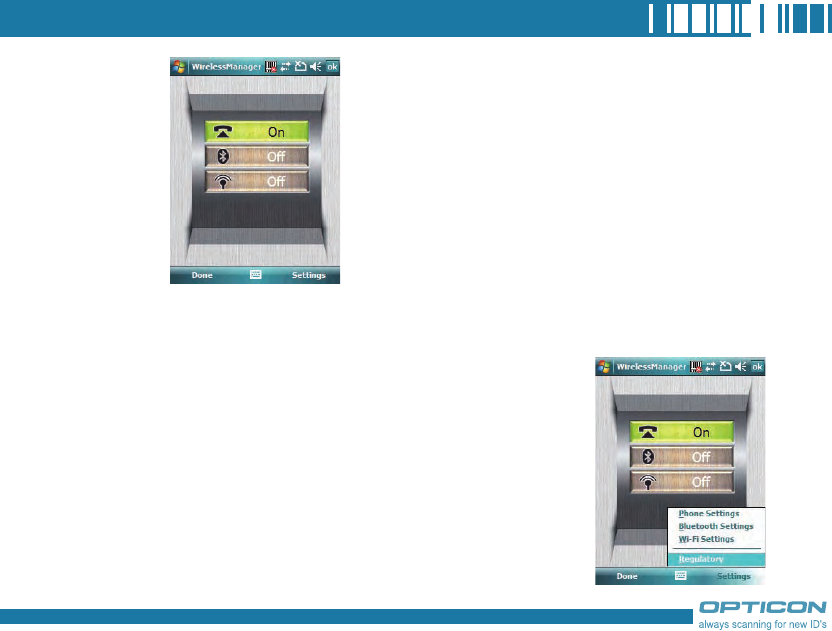
119
• Tap the first button to toggle between enabling or disabling the phone.
• Tap the second button to toggle between turning on or off Bluetooth.
• Tap the third button to toggle between turning on or off Wi-Fi.
Changing Regulatory Setting
The regulations for the frequency, channel and power of Wi-Fi and
Bluetooth are varied in different regions. You can adapt a country’
s telecommunications regulatory settings while you use your device to
access wireless networks in the country.
1. Open Wireless Manager and then tap Settings > Regulatory.
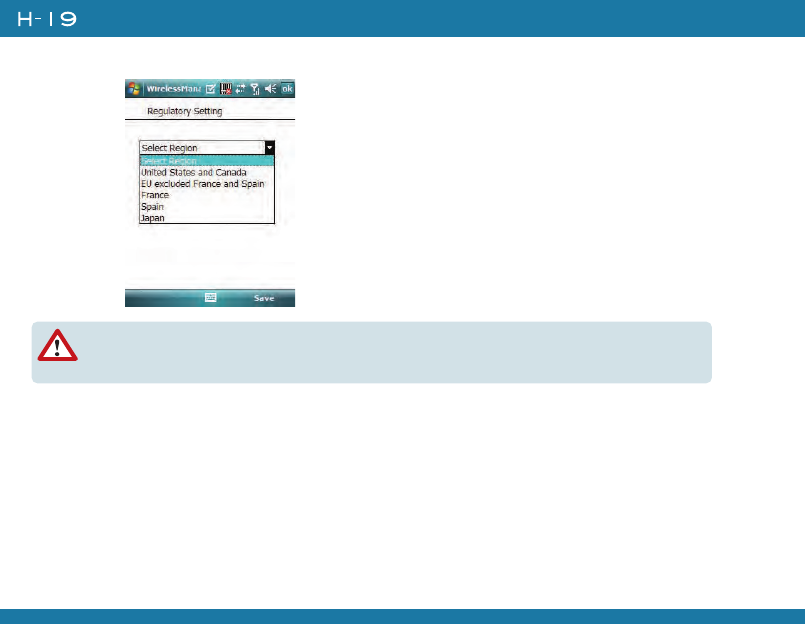
120
Chapter 7. Connecting to the Internet
2. Select a country/region in which you use this device. Tap Save to confirm the setting.
Wi-Fi can not be turned on if the Regulatory Setting is not specified.
Your device will restart automatically after you change the regulatory setting.
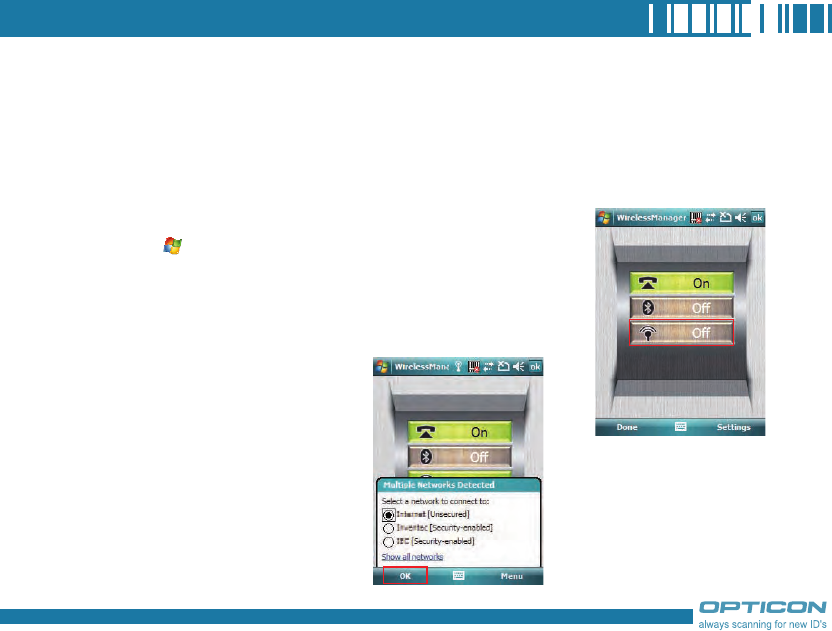
121
7.4 Using a Wi-Fi Connection
Wi-Fi is an enabling technology that allows you to quickly access e-mail, the internet, and broadband
multimedia content. When your device encounters a hotspot (a place where you can access Wi-Fi
networks), it can then connect to that network wirelessly. While some hotspots are free, the most robust
public Wi-Fi networks are provided by private internet service providers (ISPs) that charge a fee for
users to connect to the internet.
Connecting to a Wi-Fi Network
1. Tap > Settings > Connections tab > Wireless Manager.
2. Tap the third button to turn on Wi-Fi connection.
3. Available wireless networks will be
detected and showed on a pop-up
window. Select the desired wireless
network and tap OK.
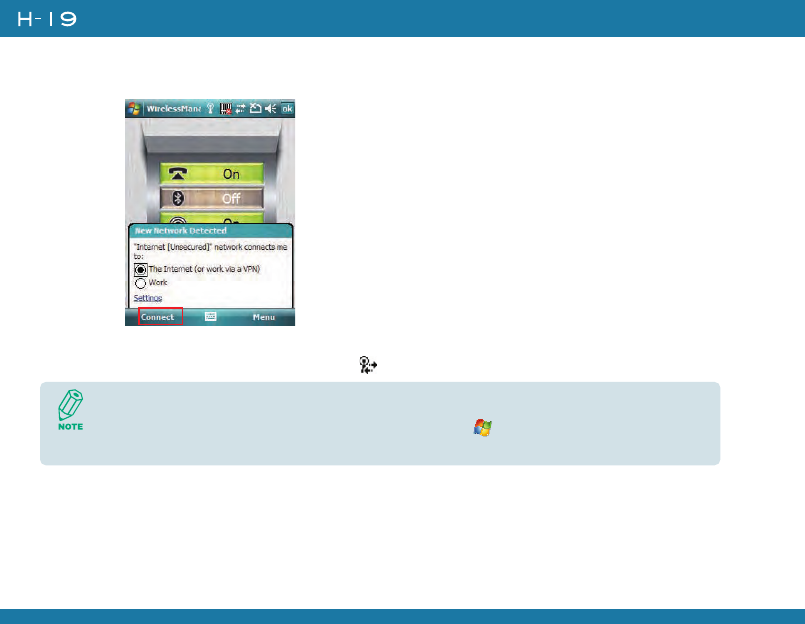
122
Chapter 7. Connecting to the Internet
4. Select The Internet if the wireless network connects your device to the Internet; select Work if
the wireless network connects to a private network. Then tap Connect.
5. Enter a network key if required. Then tap Connect.
6. When Wi-Fi connection is activated, the icon shows on the title bar.
You may need to consult your ISP before you try to run this utility.
You can obtain the Wi-Fi address of your device. Tap > Settings > System tab >
Device Info > Hardware tab and refer to WiFi MAC Address.
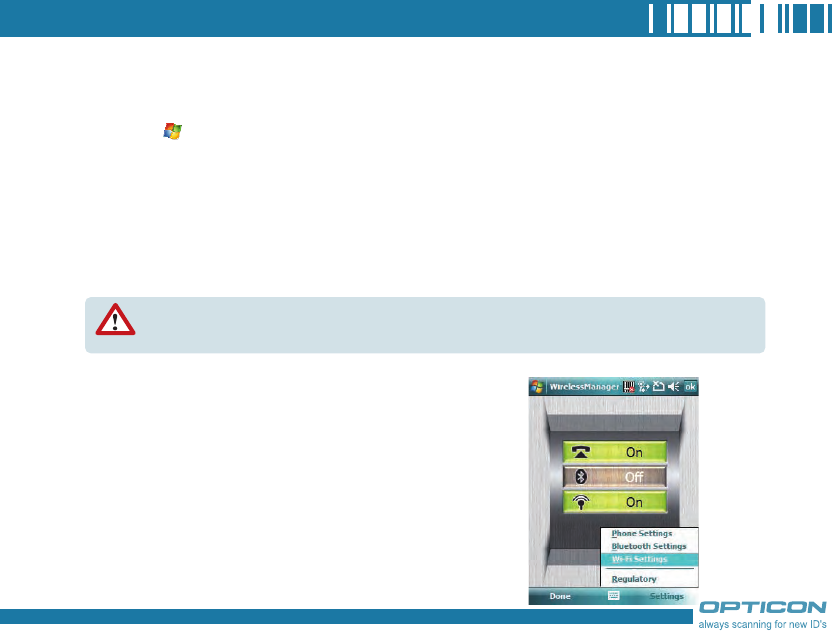
123
Checking Wi-Fi Connection
You can check the current wireless connection status via Wi-Fi Network Manager after connecting
to a Wi-Fi Network.
1. Tap > Settings > Connections tab > Wi-Fi Network Manager.
2. In Status tab, you can see information of link status, SSID, Signal strength…etc.
3. In Info tab, you can check values of servers and IP address and renew IP if needed.
4. In Advanced tab, you can refer to MAC address and version information.
Configuring Wi-Fi Settings
You can configure wireless networks on your device by adding new Wi-Fi connections and editing
currently available networks.
Creating a Wireless Connection
1. Open Wireless Manager and then tap Settings > Wi-Fi
Settings.
The screen for wireless networks configuration can only be accessed after Wi-Fi is turned
on.
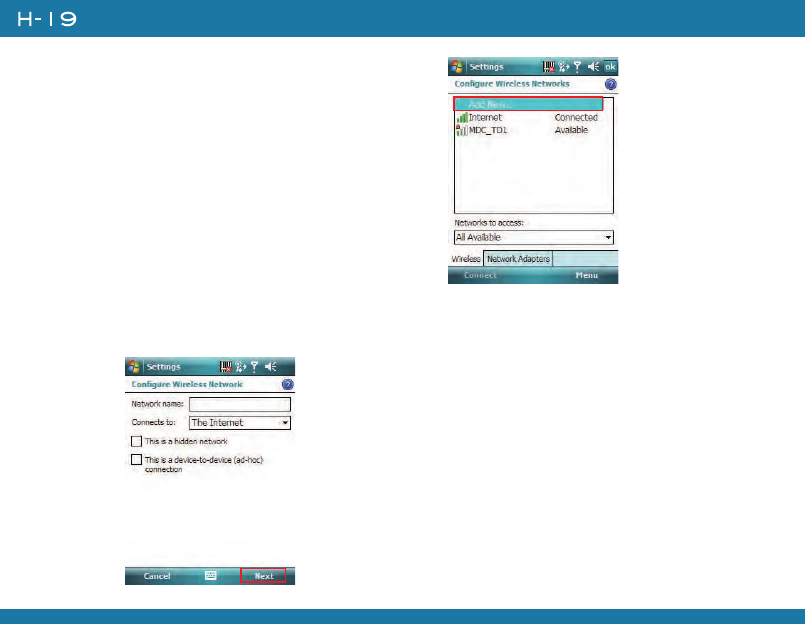
124
Chapter 7. Connecting to the Internet
2. In the Wireless tab, tap Add New… on the screen.
3. Enter the Network name and Network
type, then tap Next. If you want to
connect to another device instead of a
network through an access point, select
This is a device-to-device (ad-hoc)
connection.
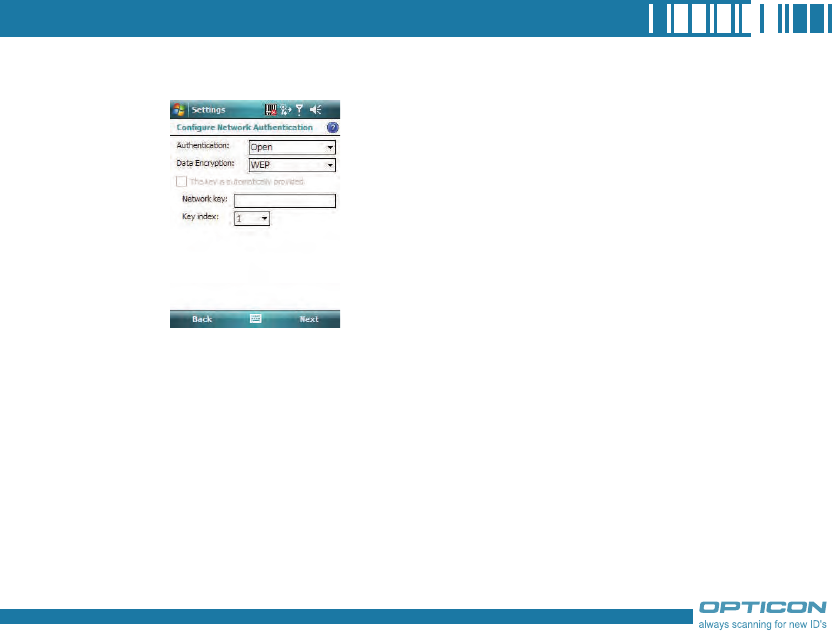
125
4. Select Authentication type and Data Encryption and enter the Network key and Key
index if needed. Tap Next.
5. Select Use IEEE 802.1x network access control to use EAP (Extensible Authentication
Protocol). Select EAP type: PEAP or Smart Card or Certificate.
6. Tap Finish.
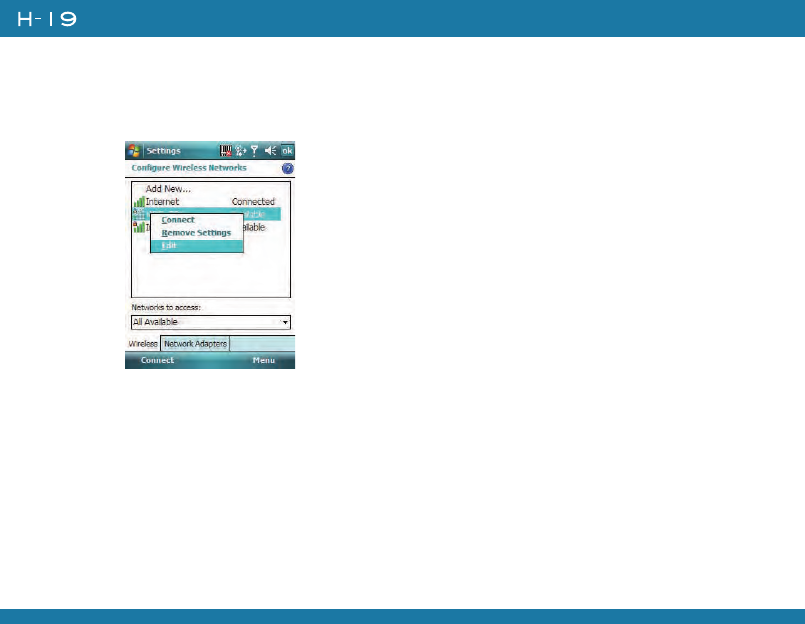
126
Chapter 7. Connecting to the Internet
Editing a Wireless Network
1. Open Wireless Manager and then tap Settings > Wi-Fi Settings.
2. In Wireless tab, you can see currently available wireless networks. Tab and hold the network
you want to edit, and then tap Edit on the pop-up screen.
3. Changing settings of this wireless network and tap Finish to save them.